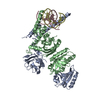[English] 日本語
 Yorodumi
Yorodumi- PDB-7xi3: Crystal Structure of the NPAS4-ARNT2 heterodimer in complex with DNA -
+ Open data
Open data
- Basic information
Basic information
| Entry | Database: PDB / ID: 7xi3 | ||||||
|---|---|---|---|---|---|---|---|
| Title | Crystal Structure of the NPAS4-ARNT2 heterodimer in complex with DNA | ||||||
 Components Components |
| ||||||
 Keywords Keywords | TRANSCRIPTION/DNA / TRANSCRIPTION-DNA COMPLEX | ||||||
| Function / homology |  Function and homology information Function and homology informationnervous system development / cell differentiation / protein heterodimerization activity / regulation of DNA-templated transcription / DNA binding / nucleoplasm Similarity search - Function | ||||||
| Biological species |  | ||||||
| Method |  X-RAY DIFFRACTION / X-RAY DIFFRACTION /  SYNCHROTRON / SYNCHROTRON /  MOLECULAR REPLACEMENT / Resolution: 4.274 Å MOLECULAR REPLACEMENT / Resolution: 4.274 Å | ||||||
 Authors Authors | Sun, X.N. / Jing, L.Q. / Li, F.W. / Wu, D.L. | ||||||
| Funding support |  China, 1items China, 1items
| ||||||
 Citation Citation |  Journal: Proc.Natl.Acad.Sci.USA / Year: 2022 Journal: Proc.Natl.Acad.Sci.USA / Year: 2022Title: Structures of NPAS4-ARNT and NPAS4-ARNT2 heterodimers reveal new dimerization modalities in the bHLH-PAS transcription factor family. Authors: Sun, X. / Jing, L. / Li, F. / Zhang, M. / Diao, X. / Zhuang, J. / Rastinejad, F. / Wu, D. | ||||||
| History |
|
- Structure visualization
Structure visualization
| Structure viewer | Molecule:  Molmil Molmil Jmol/JSmol Jmol/JSmol |
|---|
- Downloads & links
Downloads & links
- Download
Download
| PDBx/mmCIF format |  7xi3.cif.gz 7xi3.cif.gz | 152.3 KB | Display |  PDBx/mmCIF format PDBx/mmCIF format |
|---|---|---|---|---|
| PDB format |  pdb7xi3.ent.gz pdb7xi3.ent.gz | 113.2 KB | Display |  PDB format PDB format |
| PDBx/mmJSON format |  7xi3.json.gz 7xi3.json.gz | Tree view |  PDBx/mmJSON format PDBx/mmJSON format | |
| Others |  Other downloads Other downloads |
-Validation report
| Summary document |  7xi3_validation.pdf.gz 7xi3_validation.pdf.gz | 422.6 KB | Display |  wwPDB validaton report wwPDB validaton report |
|---|---|---|---|---|
| Full document |  7xi3_full_validation.pdf.gz 7xi3_full_validation.pdf.gz | 434.2 KB | Display | |
| Data in XML |  7xi3_validation.xml.gz 7xi3_validation.xml.gz | 15 KB | Display | |
| Data in CIF |  7xi3_validation.cif.gz 7xi3_validation.cif.gz | 21.8 KB | Display | |
| Arichive directory |  https://data.pdbj.org/pub/pdb/validation_reports/xi/7xi3 https://data.pdbj.org/pub/pdb/validation_reports/xi/7xi3 ftp://data.pdbj.org/pub/pdb/validation_reports/xi/7xi3 ftp://data.pdbj.org/pub/pdb/validation_reports/xi/7xi3 | HTTPS FTP |
-Related structure data
| Related structure data |  7xhvC  7xi4C  4zpkS S: Starting model for refinement C: citing same article ( |
|---|---|
| Similar structure data | Similarity search - Function & homology  F&H Search F&H Search |
- Links
Links
- Assembly
Assembly
| Deposited unit | 
| ||||||||
|---|---|---|---|---|---|---|---|---|---|
| 1 |
| ||||||||
| Unit cell |
|
- Components
Components
| #1: Protein | Mass: 44215.363 Da / Num. of mol.: 1 / Fragment: ARNT2 Source method: isolated from a genetically manipulated source Details: AUTHORS STATE THAT THE NCBI ACCESSION NUMBER IS OK136250 FOR THIS POLYMER. Source: (gene. exp.)   |
|---|---|
| #2: Protein | Mass: 38310.688 Da / Num. of mol.: 1 / Fragment: NPAS4 Source method: isolated from a genetically manipulated source Source: (gene. exp.)   |
| #3: DNA chain | Mass: 5034.262 Da / Num. of mol.: 1 Source method: isolated from a genetically manipulated source Source: (gene. exp.)   |
| #4: DNA chain | Mass: 4763.108 Da / Num. of mol.: 1 Source method: isolated from a genetically manipulated source Source: (gene. exp.)   |
-Experimental details
-Experiment
| Experiment | Method:  X-RAY DIFFRACTION / Number of used crystals: 1 X-RAY DIFFRACTION / Number of used crystals: 1 |
|---|
- Sample preparation
Sample preparation
| Crystal | Density Matthews: 2.98 Å3/Da / Density % sol: 58.69 % / Mosaicity: 0.706 ° |
|---|---|
| Crystal grow | Temperature: 289 K / Method: vapor diffusion / pH: 8 / Details: sodium citrate tribasic, PEG3350 |
-Data collection
| Diffraction | Mean temperature: 100 K / Serial crystal experiment: N | |||||||||||||||||||||||||||||||||||||||||||||||||||||||||||||||||||||||||||||||||||||||||||||||||||||||||||||||||||||||||||||||||||||||||||||||||||||||||||||||||||||||||||||||||||||||||||||
|---|---|---|---|---|---|---|---|---|---|---|---|---|---|---|---|---|---|---|---|---|---|---|---|---|---|---|---|---|---|---|---|---|---|---|---|---|---|---|---|---|---|---|---|---|---|---|---|---|---|---|---|---|---|---|---|---|---|---|---|---|---|---|---|---|---|---|---|---|---|---|---|---|---|---|---|---|---|---|---|---|---|---|---|---|---|---|---|---|---|---|---|---|---|---|---|---|---|---|---|---|---|---|---|---|---|---|---|---|---|---|---|---|---|---|---|---|---|---|---|---|---|---|---|---|---|---|---|---|---|---|---|---|---|---|---|---|---|---|---|---|---|---|---|---|---|---|---|---|---|---|---|---|---|---|---|---|---|---|---|---|---|---|---|---|---|---|---|---|---|---|---|---|---|---|---|---|---|---|---|---|---|---|---|---|---|---|---|---|---|---|
| Diffraction source | Source:  SYNCHROTRON / Site: SYNCHROTRON / Site:  SSRF SSRF  / Beamline: BL10U2 / Wavelength: 0.979183 Å / Beamline: BL10U2 / Wavelength: 0.979183 Å | |||||||||||||||||||||||||||||||||||||||||||||||||||||||||||||||||||||||||||||||||||||||||||||||||||||||||||||||||||||||||||||||||||||||||||||||||||||||||||||||||||||||||||||||||||||||||||||
| Detector | Type: SIEMENS-NICOLET / Detector: PIXEL / Date: Jul 18, 2021 / Details: mirrors | |||||||||||||||||||||||||||||||||||||||||||||||||||||||||||||||||||||||||||||||||||||||||||||||||||||||||||||||||||||||||||||||||||||||||||||||||||||||||||||||||||||||||||||||||||||||||||||
| Radiation | Monochromator: Ni FILTER / Protocol: SINGLE WAVELENGTH / Monochromatic (M) / Laue (L): M / Scattering type: x-ray | |||||||||||||||||||||||||||||||||||||||||||||||||||||||||||||||||||||||||||||||||||||||||||||||||||||||||||||||||||||||||||||||||||||||||||||||||||||||||||||||||||||||||||||||||||||||||||||
| Radiation wavelength | Wavelength: 0.979183 Å / Relative weight: 1 | |||||||||||||||||||||||||||||||||||||||||||||||||||||||||||||||||||||||||||||||||||||||||||||||||||||||||||||||||||||||||||||||||||||||||||||||||||||||||||||||||||||||||||||||||||||||||||||
| Reflection | Resolution: 4.274→50 Å / Num. obs: 8463 / % possible obs: 99 % / Redundancy: 9.3 % / Biso Wilson estimate: 46.27 Å2 / Rmerge(I) obs: 0.181 / Rpim(I) all: 0.062 / Rrim(I) all: 0.192 / Χ2: 0.853 / Net I/σ(I): 4.1 | |||||||||||||||||||||||||||||||||||||||||||||||||||||||||||||||||||||||||||||||||||||||||||||||||||||||||||||||||||||||||||||||||||||||||||||||||||||||||||||||||||||||||||||||||||||||||||||
| Reflection shell | Diffraction-ID: 1
|
- Processing
Processing
| Software |
| ||||||||||||||||||||||||
|---|---|---|---|---|---|---|---|---|---|---|---|---|---|---|---|---|---|---|---|---|---|---|---|---|---|
| Refinement | Method to determine structure:  MOLECULAR REPLACEMENT MOLECULAR REPLACEMENTStarting model: 4ZPK Resolution: 4.274→15.969 Å / SU ML: 0.59 / Cross valid method: THROUGHOUT / σ(F): 1.35 / Phase error: 29.26 / Stereochemistry target values: ML
| ||||||||||||||||||||||||
| Solvent computation | Shrinkage radii: 0.9 Å / VDW probe radii: 1.11 Å / Solvent model: FLAT BULK SOLVENT MODEL | ||||||||||||||||||||||||
| Displacement parameters | Biso max: 117.84 Å2 / Biso mean: 50.1771 Å2 / Biso min: 22.04 Å2 | ||||||||||||||||||||||||
| Refinement step | Cycle: final / Resolution: 4.274→15.969 Å
| ||||||||||||||||||||||||
| LS refinement shell | Refine-ID: X-RAY DIFFRACTION / Rfactor Rfree error: 0
|
 Movie
Movie Controller
Controller


 PDBj
PDBj






































